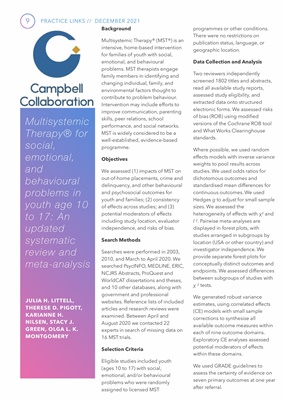
9 PRACTICE LINKS // DECEMBER 2021
JULIA H. LITTELL,
THERESE D. PIGOTT,
KARIANNE H.
NILSEN, STACY J.
GREEN, OLGA L. K.
MONTGOMERY
Multisystemic
Therapy® for
social,
emotional,
and
behavioural
problems in
youth age 10
to 17: An
updated
systematic
review and
meta-analysis Background
Multisystemic Therapy® (MST®) is an
intensive, home-based intervention
for families of youth with social,
emotional, and behavioural
problems. MST therapists engage
family members in identifying and
changing individual, family, and
environmental factors thought to
contribute to problem behaviour.
Intervention may include efforts to
improve communication, parenting
skills, peer relations, school
performance, and social networks.
MST is widely considered to be a
well-established, evidence-based
programme.
Objectives
We assessed (1) impacts of MST on
out-of-home placements, crime and
delinquency, and other behavioural
and psychosocial outcomes for
youth and families; (2) consistency
of effects across studies; and (3)
potential moderators of effects
including study location, evaluator
independence, and risks of bias.
Search Methods
Searches were performed in 2003,
2010, and March to April 2020. We
searched PsycINFO, MEDLINE, ERIC,
NCJRS Abstracts, ProQuest and
WorldCAT dissertations and theses,
and 10 other databases, along with
government and professional
websites. Reference lists of included
articles and research reviews were
examined. Between April and
August 2020 we contacted 22
experts in search of missing data on
16 MST trials.
Selection Criteria
Eligible studies included youth
(ages 10 to 17) with social,
emotional, and/or behavioural
problems who were randomly
assigned to licensed MST
programmes or other conditions.
There were no restrictions on
publication status, language, or
geographic location.
Data Collection and Analysis
Two reviewers independently
screened 1802 titles and abstracts,
read all available study reports,
assessed study eligibility, and
extracted data onto structured
electronic forms. We assessed risks
of bias (ROB) using modified
versions of the Cochrane ROB tool
and What Works Clearinghouse
standards.
Where possible, we used random
effects models with inverse variance
weights to pool results across
studies. We used odds ratios for
dichotomous outcomes and
standardised mean differences for
continuous outcomes. We used
Hedges g to adjust for small sample
sizes. We assessed the
heterogeneity of effects with χ2 and
I 2. Pairwise meta-analyses are
displayed in forest plots, with
studies arranged in subgroups by
location (USA or other country) and
investigator independence. We
provide separate forest plots for
conceptually distinct outcomes and
endpoints. We assessed differences
between subgroups of studies with
χ 2 tests.
We generated robust variance
estimates, using correlated effects
(CE) models with small sample
corrections to synthesise all
available outcome measures within
each of nine outcome domains.
Exploratory CE analyses assessed
potential moderators of effects
within these domains.
We used GRADE guidelines to
assess the certainty of evidence on
seven primary outcomes at one year
after referral.